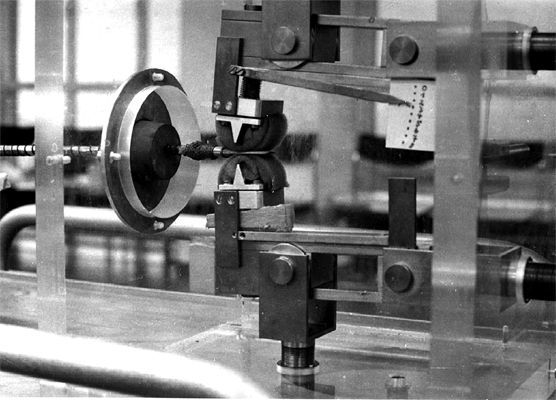In the years 1966/67 Frans Fransson founds out, that the sound generating function of double-reed woodwind instruments corresponds to a chain of pressure pulses, which determines the envelope of the sound spectrum (Fransson 1966; Fransson 1967): The spectral envelope gets gaps and between them spectral maxima: the so called formants.
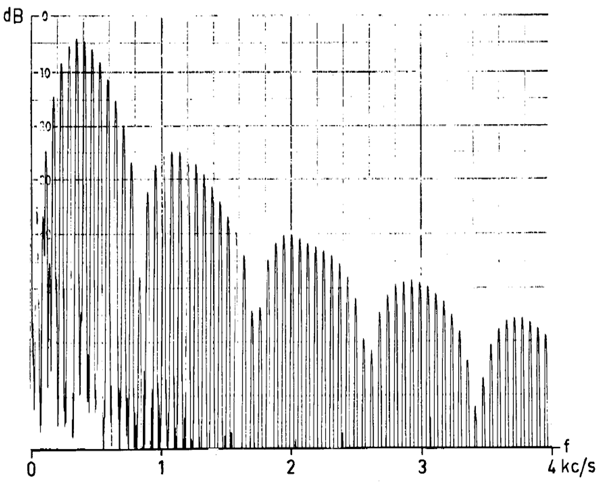
Source spectrum with typical formant areas in the case of the bassoon
(Fransson 1966)
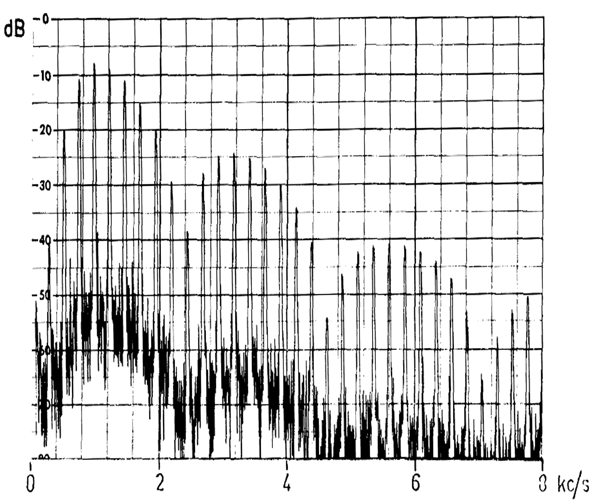
Source spectrum with typical formant areas in the case of the oboe
(Fransson 1967)
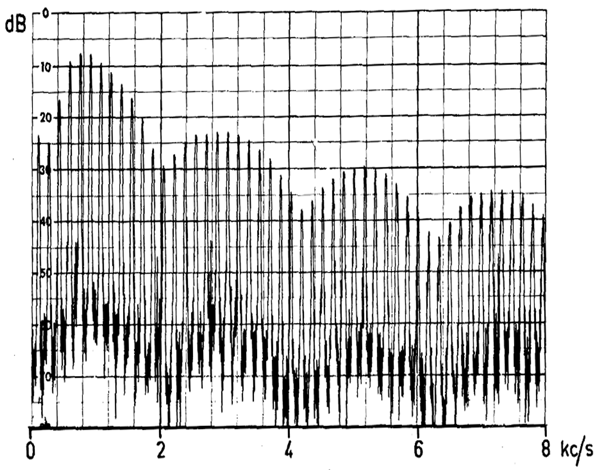
Source spectrum with typical formant areas in the case of the english
horn
(Fransson 1967)
(Formant = formants (formant areas) are stable areas in the spectrum, where the amplitude of the partials is particularly strong, independent of the pitch of the fundamental. These areas or spectral maxima are characteristic for each instrument and are responsible for the impression of the typical instruments timbre).
It could be shown that wind instrument timbres mostly are generated by this principle. The characteristic timbre of a wind instrument is only a result of the shape of the excitating pulses. In the case of original wind instruments these pulse chains are generated by the valve function of the (double) reed or lips.
Measurement of the double-reeds opening and closing time in the case of the bassoon (Voigt 1975):
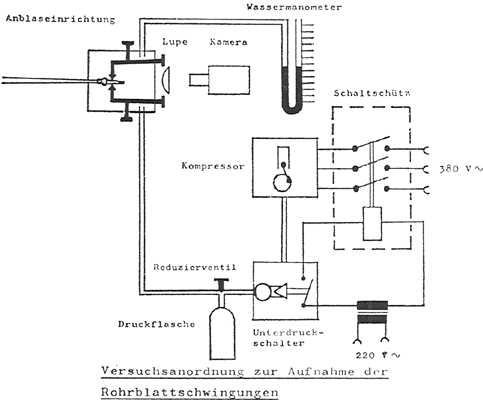
Experimental setup for the double-reed movements recording
(Voigt 1975)
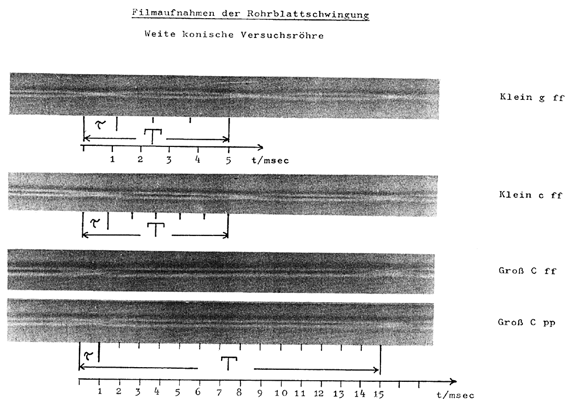
Double reed movement recording (1000 pictures/second)
(Voigt 1975)
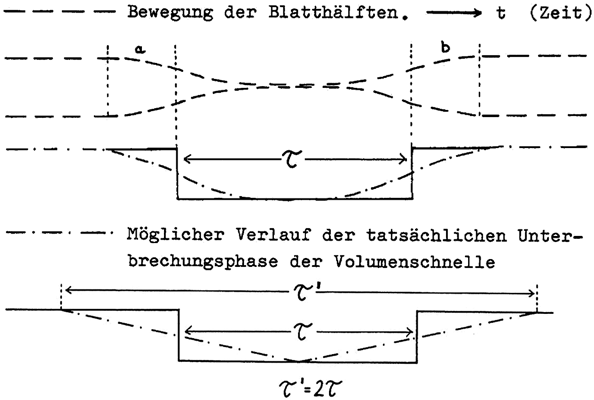
Cosine-shaped closing time of the reeds, approached to a rectangle function
(Voigt 1975)
The steady opening and closing of the reeds or lips is modeled by the pulse forming process: Instead of a short opening of the lips/reeds a corresponding shaped electronic pulse is used for synthesis.
According to the theory of the creation of cyclical spetra by pulse chains there are the following principles to modify the spectral shape:
The basic condition for stable formant areas are constant closing times
of the (double) reeds or lips, independent of the pulse frequency (period).
This means: The speed or frequency of the pulse chain does not matter,
only the width of the pulses (i.e. closing times) have to be constant.
The smallest change of the pulse width causes a certain micromodulatoric
change in the timbre, which is typical for musical instruments. With other
words: constant pulse widhts cause constant formant areas and constant
spectral gaps. Minimal changes of the pulse width cause audible changes
in the spectrum.
The principle works like this: Assuming a pulse width of t and a period
of T one can find the spectral gaps at the partials 1/t (or 1/T-t, if
the constant period T-t <= T)(this corresponds to the principle of
formant areas, discovered by Karl Erich Schumann in the 1920ies).
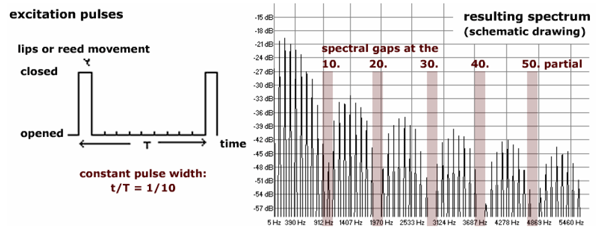
constant pulse chain and its spectrum (t/T = 1/10)
(Oehler, Reuter 2005)
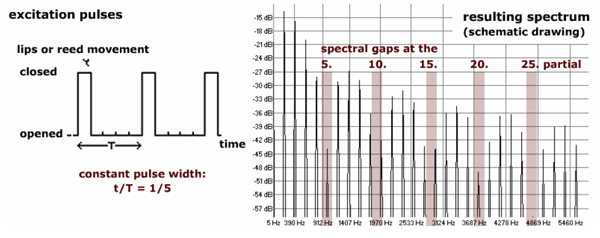
constant pulse chain and its spectrum (t/T = 1/5)
(Oehler, Reuter 2005)
In the case of timbres played in low dynamics (pp) the
pulse shape is rounded. This means for the spectrum, that the higher
partials are not so strongly marked as normal.
In the case of timbres played in stronger dynamics (ff) the pulse shape
is edged. This means for the spectrum, that the higher partials are
stronger prominent as normal.
With other words: The more edged the pulse shape the stronger the amplitudes
of the higher partials.
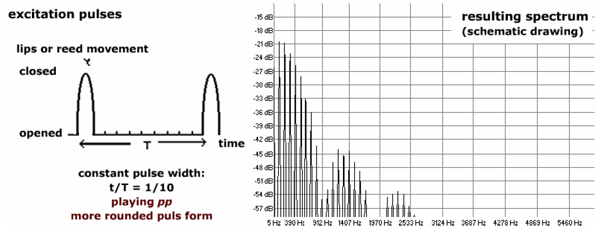
rounded pulse form and its spectrum (in pp)
(Oehler, Reuter 2005)
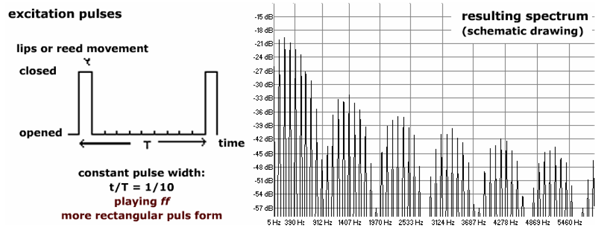
edged pulse form and its spectrum (in ff)
(Oehler, Reuter 2005)
In the case of a minimal shortening of the pulse width the spectral gaps
and maxima (formants) move to higher partials. This is the case by crescendo
playing wind instruments and corresponds the the principle of shifting
formant areas found by Karl Erich Schumann in the 1920ies.
(one hase the reverse case by decrescendo playing wind instruments (longer
pulse width cause a shifting of the spectral minima and maxima to lower
partials)).
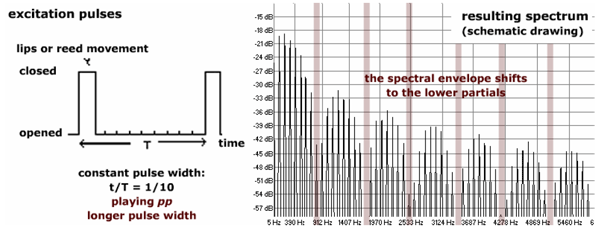
a wider pulse width in pp leads to smaller formant areas between the spectral
gaps
(Oehler, Reuter 2005)
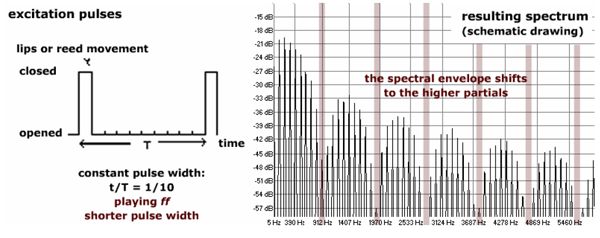
a smaller pulse width in ff leads to wider formant areas between the spectral
gaps
(Oehler, Reuter 2005)
The pulse forming process of the Variophon and of the Martinetta works with rectangular pulses. This is not the case in the sound generation of real instruments: Here one would get only rectangle pulses in the sound generating process, if the opening and closing times of the reeds/lips would be infinite small. But this is not the case: Between the "open" and "close" state is a small transitory distance. So one has to assume cosine or triangle shaped pulses in the sound generating process of wind instruments to be absolutely correct. But the rectangle shaped pulses work very well for the wind instrument synthetisation.
The following principles are valid for the pulse forming process with triangle shaped pulses:
The distribution of the spectral gaps is dependent on the attack and decay time (t1 and t2-t1) of the triangle shaped pulse (t2) inside a cycle (T): As long as the decay time (t2-t1) has a harmonic ratio to the whole cycle (T) and as long as the ratio between attack and decay time (t1 and t2-t1) stays constant, the positions of the spectral maxima and minima remain constant also.
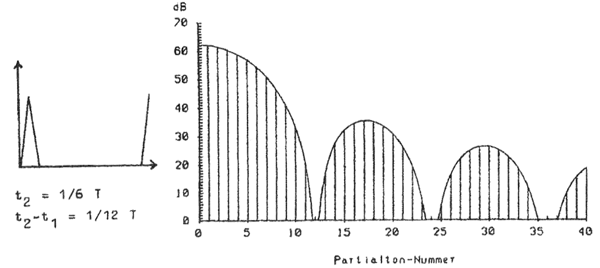
triangle shaped pulses and their spectrum (t2 = 1/6 T and t2-t1
= 1/12 T)
(Auhagen 1987)
The ratio between the decay time (t2-t1) and the whole cylcle (T) determines
the main maxima and minima of the spectral envelope, whereas the ratio
between the attack time (t1) and the whole cylcle (T) causes the minor
spectral maxima and minima between the main maxima and minima of the spectral
envelope.
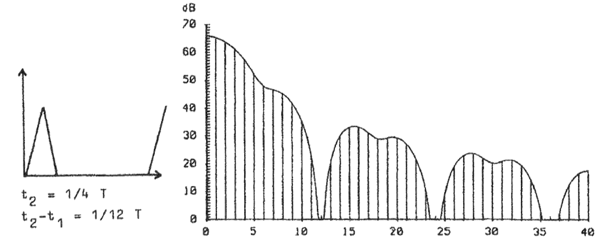 triangle shaped pulses and their spectrum (t2 = 1/4 T und t2-t1
= 1/12 T)
triangle shaped pulses and their spectrum (t2 = 1/4 T und t2-t1
= 1/12 T) (Auhagen 1987)
The principles for the spectra of cosine and composite pulses are a little more complex. They are described in the works of Blens (1993), Fricke & Blens (1994), Baumgartner (2012) and Gadermaier (2013).


